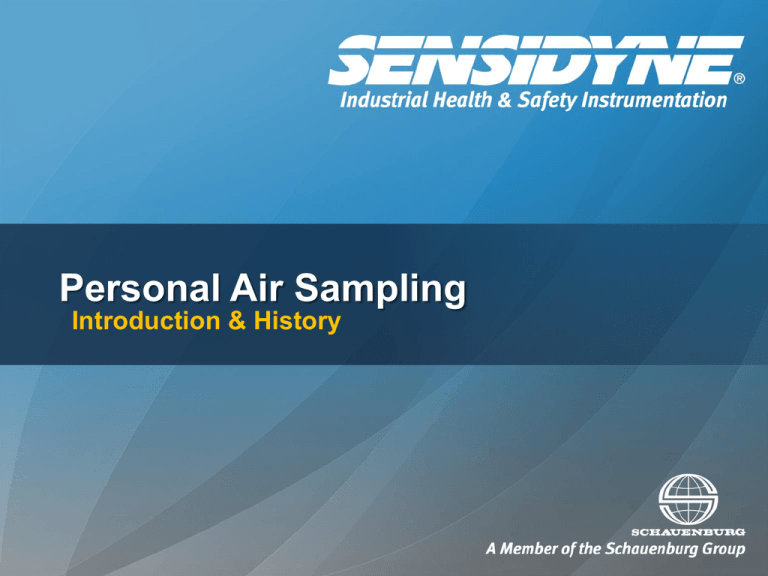Introduction to Air Sampling
advertisement

Personal Air Sampling Introduction & History Goal of Personal Sampling • Collect an air sample representative of a worker’s Breathing Zone Representative Air Sample • Conducted over the entire work shift • Collects air around the worker’s face • Doesn’t get in the way of doing the job • Provides a reliable flow rate & volume Personal Sampling History The first personal air samplers were developed for sampling coal mine workers for coal dust exposure in underground coal mines. Timeline: US Agencies • • • • • • 1910 Bureau of Mines 1913 Department of Labor 1915 Public Health Service ************************* 1969 MSHA 1970 OSHA & EPA Earliest Sampling • The earliest personal monitoring was done with a manual pump, hand-operated by a second person • The pump was developed by the US Bureau of Mines in 1937, and collected the dust in a water medium using impingers. First Battery Operated Personal Monitoring Pumps • In 1957 the first battery operated personal pumps were used, made under contract for the US Bureau of Mines • Sampling is now collected onto filters, using size selective cyclones Personal Pump History • 1937- Hand operated pump for US coal mines • 1957 – First battery operated personal monitoring pumps used in US coal mines • 1962 – Commercial pumps first sold in US & Europe • 1973 – Low flow pump & sorbent tubes • 1975 – Constant flow pumps • 1976 – High/Low flow combo pumps • 1980 – Digital calibrators • 1982 – High/Low/Constant Flow pump Personal Air Sampling Pumps • • • • Personal Pump High Flow Flow rates from 1 to 5 LPM Examples: Lead, Asbestos, Dust Accessories: Filters, Cyclones, Impingers MSHA 30 CFR Part 74 Coal Dust Sample Requirements • • • • • • • Size and weight limitations Air exhausts inside the case On-off switch & flow control protected Pulsation control Battery operated & charged in place Visual flow rate indicator Flow control to +/- 5% Personal High Flow Pump Personal Air Sampling Pumps Personal Pump Low Flow • Flow Rates from 20 to 300cc/min • Examples: Hydrocarbon Solvents (Benzene) Chlorinated Solvents (Methylene Chloride) & Alcohols • Accessories: Sorbent Tubes (Charcoal Tubes) Personal Low Flow Pump Personal Air Sampling Pumps Constant Flow Control • Works like the cruise control on a car • Senses when the flow rate is trying to drop and speeds up the pump • Maintains the flow rate at ± 5% of set flow Personal Air Sampling Pumps Multi-flow Low Flow Pumps • Constant pressure control allows two to four simultaneous samples using special manifolds • A constant low pressure level is maintained in the connection tubing • Flow rate is controlled with a needle valve on each tube holder Universal Tube Holder System Constant Flow vs. Constant Pressure Sampling Accessories Filter Cassettes Impingers Charcoal Tubes Cyclone Samplers Sorbent Tubes Three-piece Filter Cassette Personal Cyclone Sampler Calibration Setup with Filter Cassette Air Sampling Pump Calibration Primary Air Flow Calibrator Measures airflow using a Measured volume Secondary Air Flow Calibrator Gauge to measure flow. Requires comparative validation NIST Traceable Documented trail to National Institute for Science & Technology Cyclone Calibration Jar Multi-flow Calibration Back Pressure Measuring Back Pressure IH Timeline • • • • • 1939 – AIHA founded 1970 – OSHA, NIOSH, EPA 1984 – Asbestos Act 1990s – Industry downsizing 1999-2000 – Slow industry recovery AIHA Membership • • • • • • • 1939 – 160 members 1970 – 1650 members 1980 – 5000 members 1985 – 6300 members 1991 – 10,000 members 1996 – 12,500 members 2011 - 10,240 members Personal Pump Trends • • • • • 1960s – Make it work 1970s – Make it smaller 1980s – Add features 1990s – Better value 2000s – Make it smarter www.Sensidyne.com 800-451-9444 / 727-530-3602







